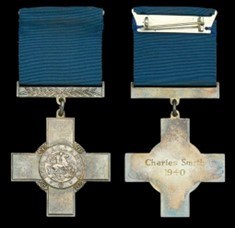City of Doncaster Council buy George Cross Awarded to Local Mineworker After Rescuing a Trapped Miner
The George Cross (originally an Edward Medal) was awarded to mineworker Charles Smith, for his gallantry in rescuing a trapper miner at Askern Main Colliery on January 3, 1940

The Cross fetched a hammer price of £12,000 in the sale of Orders, Decorations, Medals and Militaria at Noonans Mayfair on Wednesday, May 14, 2025. City of Doncaster Council has been able to purchase the medal through a donation from a private individual.
As the London Gazette of June 28, 1940, described: ‘At 10 a.m. on the 3rd January, 1940, a fall of roof occurred at a coal face in Warren House Seam at Askern Main Colliery, Yorkshire, and a miner named Charles Liversidge was buried by the fall. He was extricated some three hours later, without having suffered serious injury, through the gallantry displayed, in conditions of the greatest risk, by a rescue party.’Mayor of Doncaster Ros Jones said: “As the daughter of a miner, I am delighted that this important medal recognising a life-saving achievement at a Doncaster pit, is coming back to the city. This is an important part of our heritage and even more so, given these are so rarely awarded.
She continued: “This George Cross will find a new home in our mining and awards collection and will be put on display in Danum Gallery, Library and Museum later in the year. I hope people come and see this medal and read its story.”
Following the sale, Oliver Pepys, Auctioneer and Medal Specialist (Associate Director) Noonans commented: “Charles Smith was originally awarded the Edward Medal in bronze for his gallantry in January 1940 and was one of 319 miners awarded the Edward Medal in bronze between 1907 and 1971. In 1971, living recipients of the Edward Medal were invited to exchange their awards for the George Cross, and Smith was one of just 30 miners who had received the Edward Medal in bronze to exchange his medal for the George Cross. Exchanging the medal makes it a much rarer award, which attracted substantial interest.”
Charles Smith followed in his father’s footsteps to become a miner from the age of 12. Employed as a miner at Askern Main Colliery, near Doncaster, Yorkshire, he was awarded the Edward Medal for his gallantry in saving the life of a trapped miner, buried by a roof fall in the Warren House Seam. For this act of gallantry, he also received a Carnegie Hero Trust Fund Certificate on 25 April 1940. He was invested with his Edward Medal, alongside Gwyn Morgan and Matthew Thompson, by H.M. King George VI at Buckingham Palace on 2 July 1940.
Following his Edward Medal exploits, Smith attested for the Royal Artillery, and served with 60 Regiment during the Second World War in Burma, being advanced to the rank of Sergeant. For his wartime services he was awarded the 1939-45 Star; the Burma Star; the Defence Medal; and the War Medal 1939-45. Following demobilisation in 1945, he returned to his coal industry, and was employed on the surface as a banksman at Stargate Colliery, Ryton-on-Tyne, County Durham, from 1945 to 1961.
On 3 February 1953, while at work at the Stargate Colliery, Smith spotted a fracture in one of the main cables on the mine shaft lift, just as the lift, full of miners, was about to be lowered down the shaft; pointing this out to the foreman, the lift was emptied, and the cable replaced. In a letter to the recipient from the Colliery’s Consultative Committee, dated 19 February 1953, the Secretary of the Committee thanked him ‘for the manner in which you averted a disastrous occurrence ... we all realise just how close a call it was, and all sections unite in appreciating your presence of mind and quick reaction to signs of danger.’
Awarded a gratuity of £10 by the Durham Division of the National Coal Board, as a token of appreciation, Smith subsequently worked in the coking industry at Derwenthaugh, County Durham, from 1961 until his retirement in 1973. Having elected to exchange his Edward Medal for the George Cross, he was invested with his George Cross by H.M. Queen Elizabeth II at Buckingham Palace on July 18, 1972, and subsequently received the Silver Jubilee Medal in 1977. He died at Blaydon, County Durham, on October 25, 1987.
- Category: General
